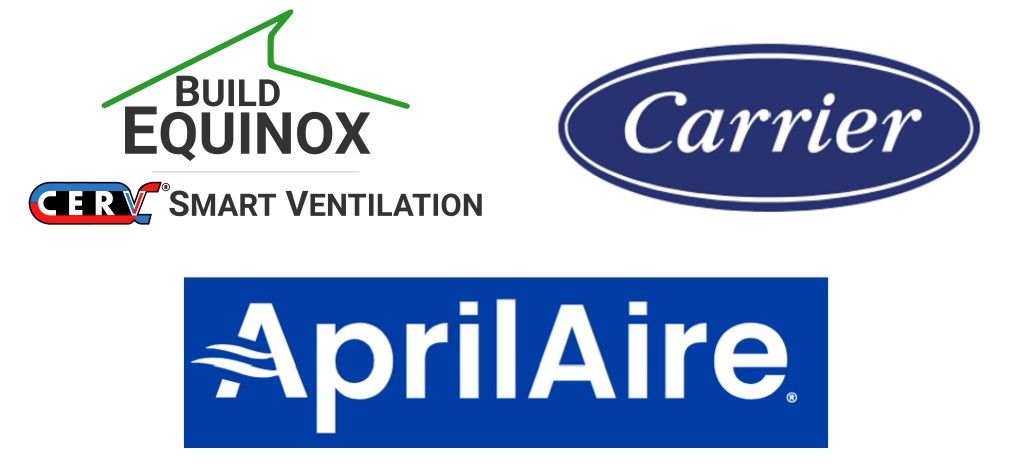
We already know that the Taylorville High School Pretty Good House (THS PGH) is more economical compared to conventional construction. We’ve modeled THS PGH’s energy, comfort, moisture management, and ventilation requirements, so we know it will be a healthy, comfortable, and energy efficient home, too. We’ve also determined each zone’s comfort conditioning loads (Manual J), and designed an energy efficient, cost optimized duct system to deliver fresh air and comfort conditioning to the home’s spaces (Manual D). In this article we specify the home’s ventilation and comfort conditioning equipment, and design a robust, efficient mechanical system that is simple to operate.
Upcoming discussion topics include hot water (with another donor announcement!), appliances, solar power, and EVs. And, we’ll follow installation of the mechanicals with Matt and students, so stay tuned!
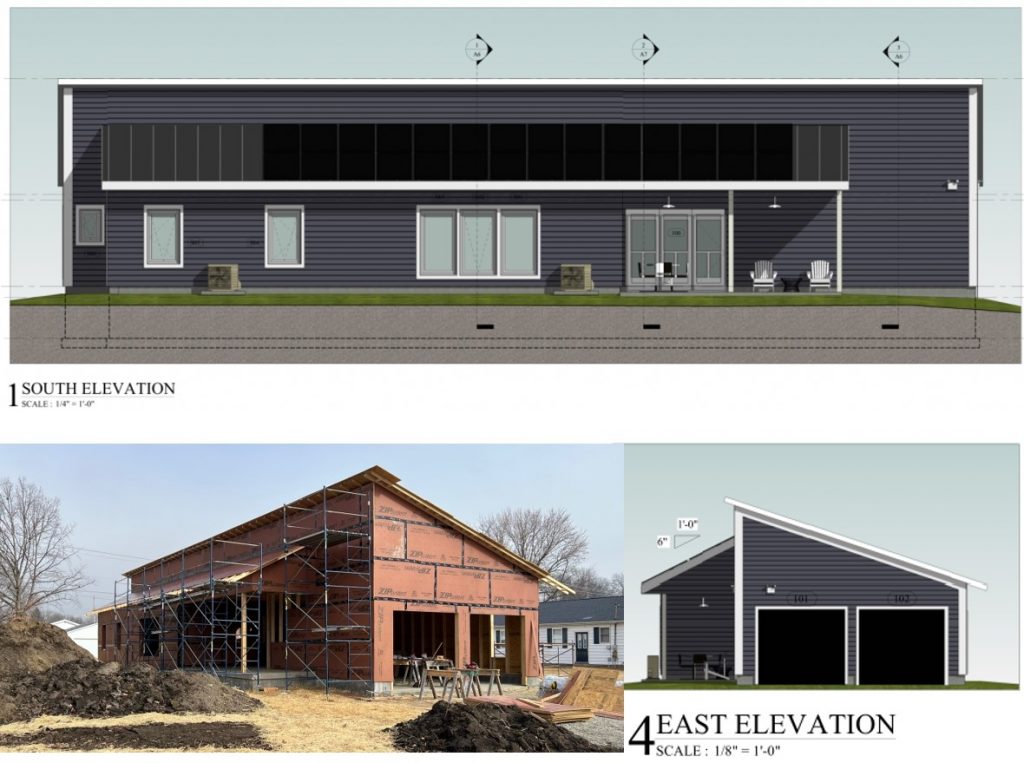
Synergistic Energy Performance
The THS PGH project uses a proven mechanical design that works great in all North American climates. The home’s mechanicals are integrated and controlled by the CERV2 in a synergistic manner, resulting in a very high system efficiency. Two aspects of the CERV2 controlled ventilation and comfort conditioning system design increases the home’s performance above other homes:
- “Excess” comfort conditioning capacity increases heating and cooling efficiency by 20 to 30%
- Dehumidification integrated with CERV2 fresh air ventilation more than doubles dehumidifier (latent) efficiency and capacity during warm and humid weather
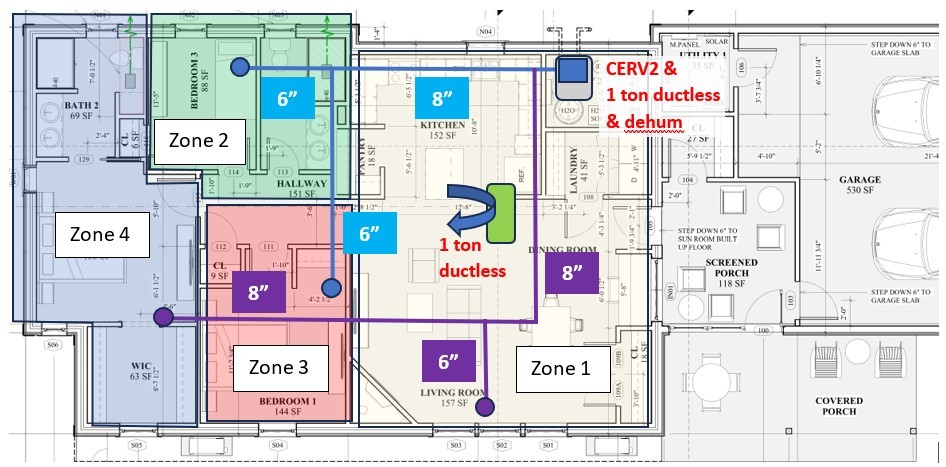
Figure 2 shows the home’s layout. In the mechanical room, a 1-ton ducted minisplit heat pump and an 80 pint per day ducted dehumidifier are integrated with the CERV2 smart ventilation system. The CERV2 controls operation of both the minisplit heat pump and the dehumidifier for seamless management of air quality and comfort. A heat pump water heater is also located in the mechanical room for convenience and efficiency reasons we will discuss in an upcoming article on water heating.
A 1-ton ductless minisplit heat pump with a wall-mounted cassette will be located in the open family room and kitchen areas, completing the HVAC mechanicals. The ductless heat pump provides comfort conditioning to the main living area while the ducted minisplit supplies conditioned air to all zones (three bedrooms and the main room).
A single 1-ton minisplit heat pump could manage most of the THS PGH comfort conditioning needs in summer and winter. Extreme cold weather (“design day conditions”) discussed in our Manual J article for the THS PGH project requires 1 ½ tons of heat, which the two 1-ton nominal capacity heat pumps are capable of providing at low outdoor temperatures.
Although one might be tempted to install only 1-ton of heat pump capacity, perhaps supplemented with an electric resistance heater during extreme cold, installing two tons of heat pump capacity has important benefits. In today’s world of inverter drive (speed controlled) compressors and fans, two 1-ton heat pumps operating at ½ ton capacity are 20 to 30% more efficient than a single 1-ton heat pump operating at full capacity.
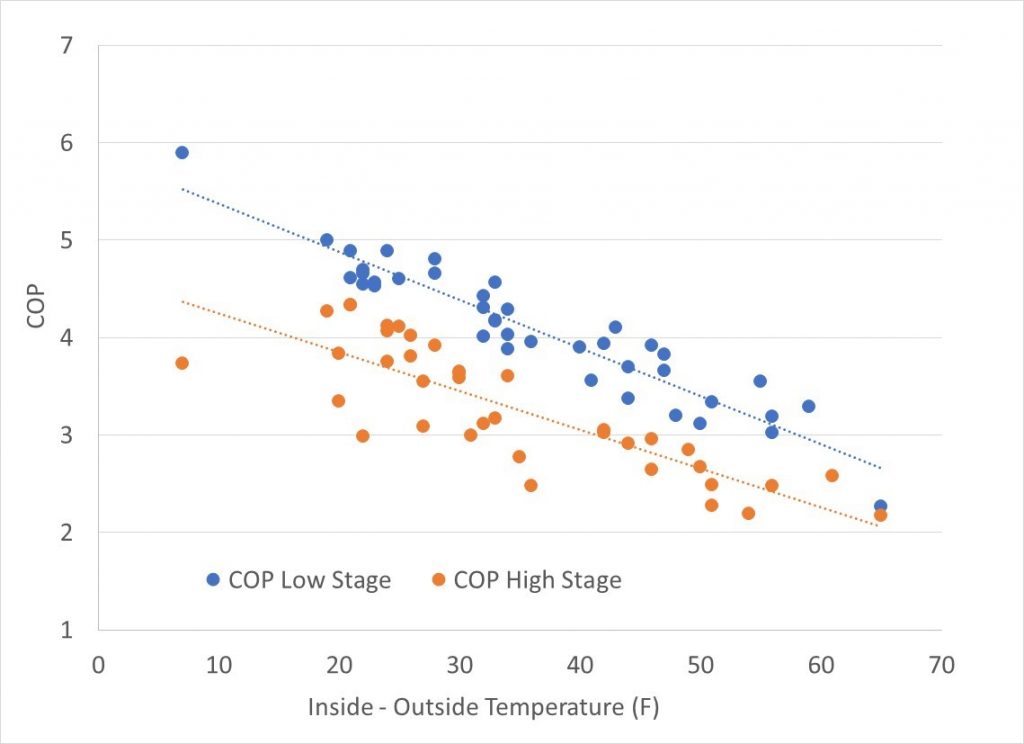
Figure 3 is data from Build Equinox laboratory showing heat pump COP for a popular low temperature ducted minisplit heat pump. COP (Coefficient of Performance) is an efficiency metric that is the ratio of heating (or cooling or air conditioning) delivered to electric power consumed. Stage 1 (low stage heating) outperforms Stage 2 (high stage heating) consistently at all temperatures. The “noise” in the data is real as internal heat pump control algorithms make operation adjustments as well as periodically defrosting coils.
Figure 3 demonstrates that Stage 1 (roughly 50% capacity) operation is 20 to 30% more efficient than Stage 2 operation. The efficiency gain is due to increased heat exchanger area per heating capacity. As compressor speed (capacity) is reduced from Stage 2 to Stage 1 operation, the ratio of heat exchange surface area to capacity increases, increasing efficiency.
In addition to a significant boost to house efficiency performance, installing “extra” heat pump capacity has other advantages:
- Zone control: two or more heat pumps provide zoned comfort control. For the THS PGH project, the ducted minisplit primarily manages bedroom comfort conditions while the ductless minisplit manages comfort in the open living space.
- Installing two or more independent minisplit heat pumps rather than a multi-head unit provides redundancy and resilience in case of one unit failing. Either one of the two minisplits will almost always maintain sufficient comfort to the home, which minimizes the need for an expensive emergency call to your local HVAC contractor in the dead of night, on a weekend, or during a holiday with a house full of visitors.
THS PGH Mechanicals Specifications
There are many good equipment choices for managing comfort in a home, whether an older renovation or a new high-performance home. Smart ventilation is essential for maintaining a healthy home, and the only smart ventilation system on the market is a CERV2, now with more than 14 years of proven field experience spread across all North American climate zones, from Newfoundland to the Florida Keys.
Here is the specification list for THE PGH project mechanicals:
- CERV2 smart ventilation unit with three wireless (battery free) switches for triggering kitchen and bathroom ventilation. Also, a CERV-IR-T wireless thermostat interface will be used for controlling the Carrier ducted minisplit heat pump
- Carrier ducted indoor unit (Model 40MBDQ12---3) paired with Carrier outdoor unit (Model 38MARBQ12AA3). This heat pump connects to the CERV2’s thermostat interface using Carrier’s thermostat interface (Model KSAIC0101230).
- Carrier ductless indoor unit (Model 40MAHBQ12XA3) paired with the same Carrier outdoor unit (Model 38MARBQ12AA3). The ductless unit will be controlled with the standard handheld IR (infrared) controller.
- AprilAire E080 ducted dehumidifier with 8 inch diameter damper for backflow prevention.

CERV2 controls are “plug-and-play” with straightforward menu selections and instructions for setup. DIYers and first time HVAC installation professionals regularly install CERV2 units with a wide array of sensors and actuators. As you’ll see, Taylorville High School students will demonstrate setting up this advanced ventilation and comfort conditioning system.
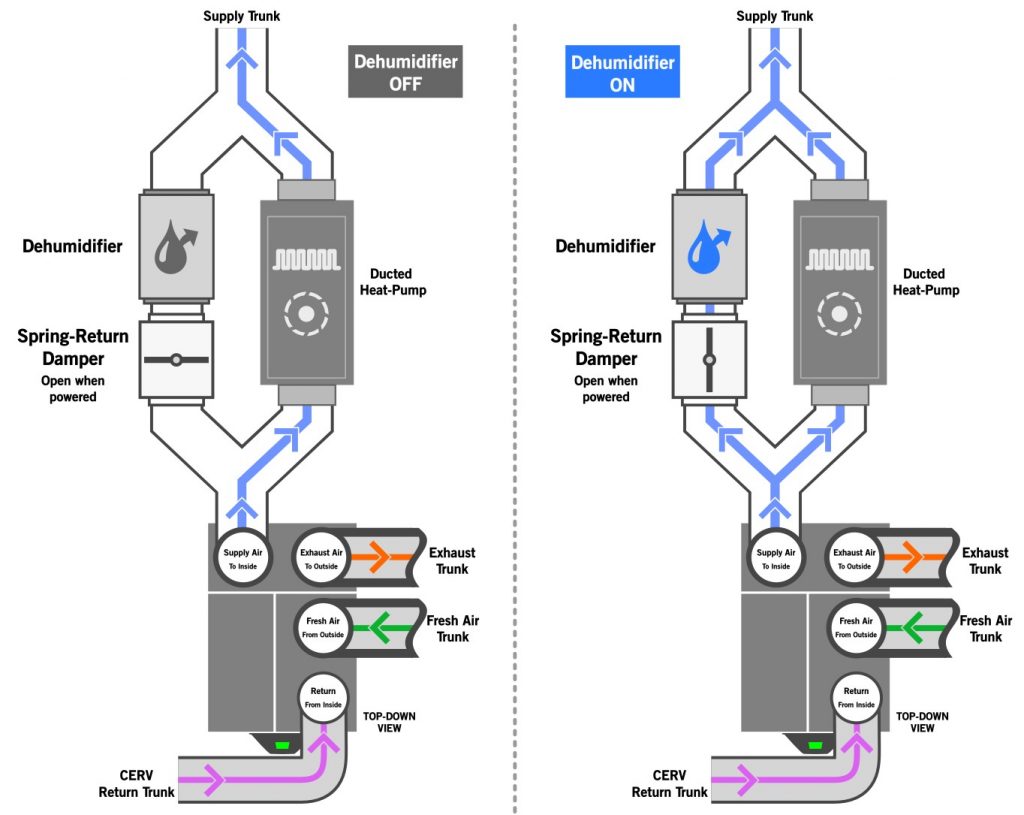
Figure 5 is a schematic of the integration of CERV2, ducted minisplit, and ducted dehumidifier components. Carrier’s thermostat interface uses standard thermostat wiring (yellow/white/green) to connect to the CERV-IR-T interface. The CERV-IR-T communicates with the CERV2 using a local low-power wireless protocol, providing secure, reliable operation without reliance on an internet connection. For homeowners who prefer no wireless connection, the CERV2 and its component options can be operated in a fully wired manner (including ethernet for online monitoring and control).
The AprilAire E080 dehumidifier unit is connected directly to the CERV2’s internal auxiliary relay. A simple menu selection designates the internal relay for dehumidification control, as described in our installation guide. An inline 8” damper (see Figure 5) prevents short circuiting of air around the ducted minisplit when the dehumidifier is not active.
We cannot stress enough the benefits of CERV2 controlled IAQ and comfort conditioning. Managing indoor air quality, temperature and humidity is a juggling act. As demonstrated by field tests and laboratory tests, the CERV2 seamlessly moves a home to desired temperature and humidity conditions, while never sacrificing fresh air and human health. In addition to excellent control of IAQ and comfort, the CERV2 amplifies the performance of both the minisplit heat pump and the ducted dehumidifier.
Next month’s article will discuss Matt and students’ field activities, including meeting Architect Emily Mottram, a founder of the PGH movement and introducing a new wood fiber insulation!























